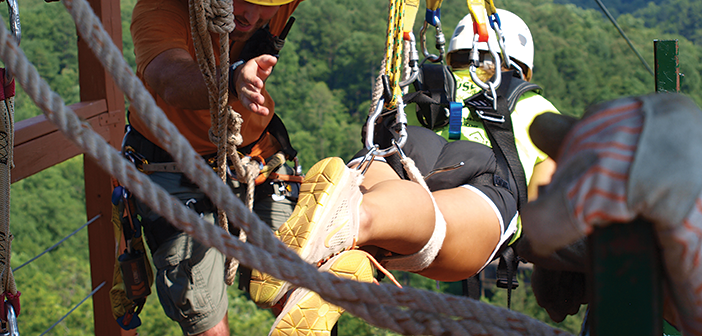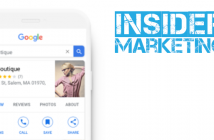Unlike WildPlay and Anakeesta, there is no urban population, no busy city vibe, and the adventure park isn’t visible to the throngs of people visiting the area. Sure, Boston is just 90 minutes away, but at Loon, the natural beauty of the western White Mountains surrounds you, and it’s not the only game in town. New Hampshire’s lake regions, among other attractions, provide serious competition.
Loon’s summer offerings are diverse. Folks can literally climb in the trees in its aerial adventure park. They can go fast or slow on mountain bikes. They can scale outdoor climbing walls with the fresh mountain air in their lungs. They can be immersed in the leafy green wild.
Still, since its audience is more far-flung than those at Niagara and Gatlinburg, Loon faces a bigger challenge in convincing the millions of people who visit the area to come buy tickets for its attractions over others. Loon attributes much of its winter success to its proximity to Boston, and it markets heavily in the city’s greater metro area. In the summer, though, says resort director of marketing Molly Mahar, it’s more about getting people who are already visiting central New Hampshire to take notice.
“In the winter, we are a destination unto ourselves,” she says. “In the summer? We are one of many attractions.” In fact, the White Mountain Association, with which Loon works closely, lists more than 20 attractions available to the swarms of folks who head north to take in the scenery in summer. “So we have to get them to notice us,” Mahar says.
Amid the noise of other attractions in the area, Loon differentiates with well-positioned, noticeable signage and slick messaging on social media. “If we didn’t have the traffic that goes by here [and a way to get them to notice], it would not make sense to do this,” says Mahar of installing the adventure park and other summer attractions.
Another adventure park that shares a similar proximity to an urban environment, but without the benefit of being in the middle of a highly visited area, is Historic Banning Mills, Ga. Located about 45 minutes outside of Atlanta, the park is a solitary attraction, with no neighbors.
Owner and founder Donna Holder has found that this location has its consequences. With millions of people in their offices or in front of their TVs in the metro area, her marketing is focused on letting these urbanites know it’s just a short jaunt to a 300-acre gorge and another thousand acres of river rich countryside. The challenge, though, is to break through the media clutter, and to constantly remind folks what is there.
“It’s frustrating,” says Holder. “We hear people say all the time, ‘We never knew you were here!’ We spend $100,000 on advertising, and they say they did not know we were here.” So Banning Mills has focused on ways to more effectively get the word out.
Today the park’s marketing is tri-fold. Holder uses a combination of search engine marketing (“it works!” she says), social media on Facebook, Twitter, and Instagram, and good old fashioned PR. Not unlike the plan for Niagara Falls, Banning Mills provides fam trips for journalists, who then share their experiences in newspaper and magazine stories. “The old way still works one of the best ways,” she says.
Even with that, some recent years have seen slower growth for Banning Mills. Says Holder, “Even though we have the largest course in the world, it has to be diversified. We have to offer new things, more things. People want to come back for more.” She also points out that the boom in new parks may be part of the slowdown in growth for them, since aerial adventurers have more choices now.
COMMON THEMES
From urban parks to more rural ones, increasing competition is on everyone’s mind. Niagara Falls’ Benson, though, wonders if growth in the number of new parks and tours will have a positive impact. “The more of us there are, the more people become aware of this experience, and the more they want to take part in it. All of our sites promote all our other sites,” he says of the WildPlay businesses across the continent.
It’s not just the number of parks and tours that could be beneficial, but the different environments they occupy, too. “Urban parks are feeders to the rest of the parks, as well as to outdoor adventure spots as a whole,” Benson says. “We are trying to get people to want to have an adventure in a natural setting. You know, there’s a massive decline in visits to natural settings [such as National Parks]over recent years. Urban adventure parks could help bring people back to an awareness of the natural world again.”
Increasingly, parks are seeking to offer a substantial half- or full-day experience. The idea is have enough options to satisfy and delight a multi-generational group or family, and make a visit worthwhile for all. “We have to have a critical mass when we open,” says Bentz of Anakeesta’s attractions. “We are going to give our guests a reason to get to the top. A chairlift with a view is not our goal. Three or four hours of fun—or even a full day of fun—for anyone from seven to 80, that’s our goal.”
At Loon, Mahar says getting people to spend the day, not just an hour or two, is a goal as well. And while Loon sells individual tickets for each attraction at its park, it also offers all-day tickets providing access to the entire park. Last season, those accounted for about 40 percent of ticket sales, a sign Loon is accomplishing its goal. Mahar points out that many people purchase more than one individual ticket to participate in the resort’s different attractions, which adds to the number of people sticking around longer.
All of these efforts can help convince urban and suburban dwellers to get out and explore their environment. “What we are doing as a whole is making people aware that this type of activity is available,” Benson says. “This is a great way to draw people into natural spaces or even natural spaces that we create. That’s good for people and good for the world.”






